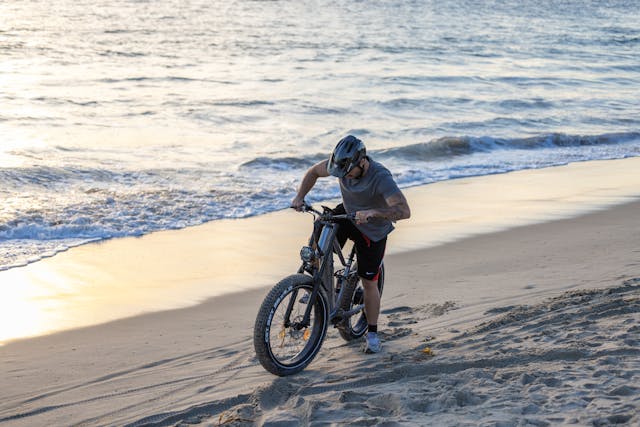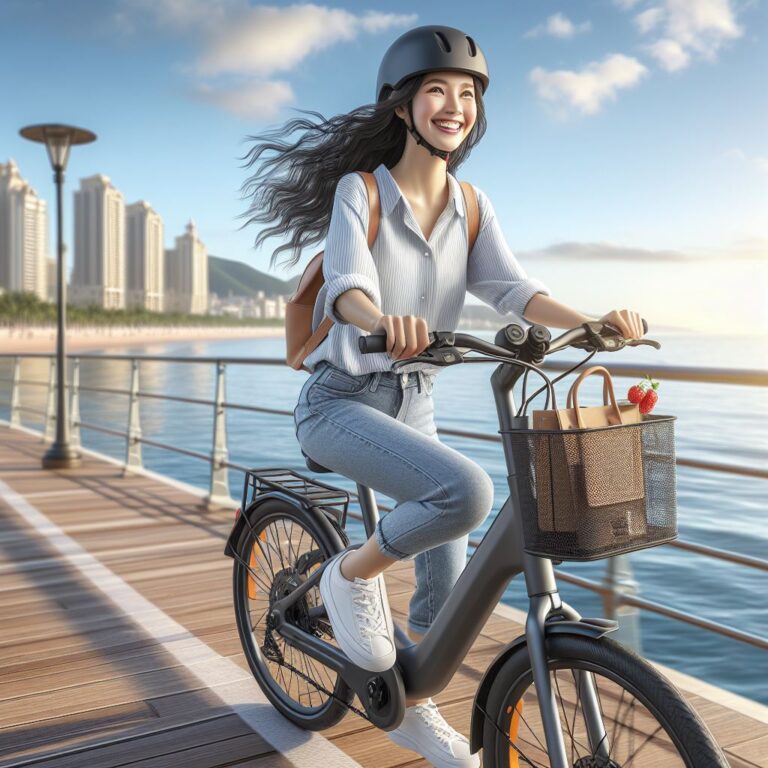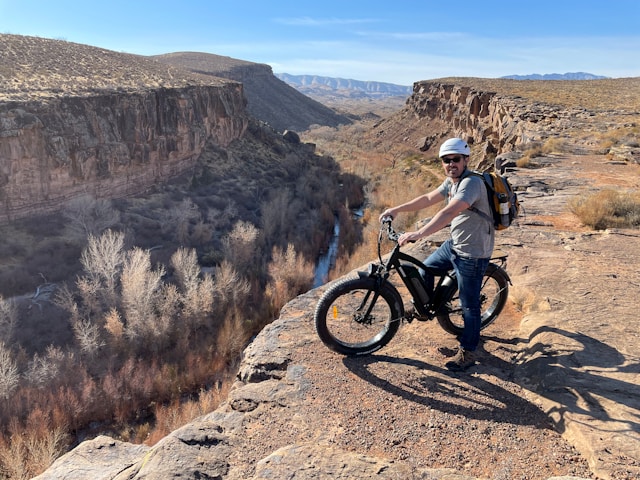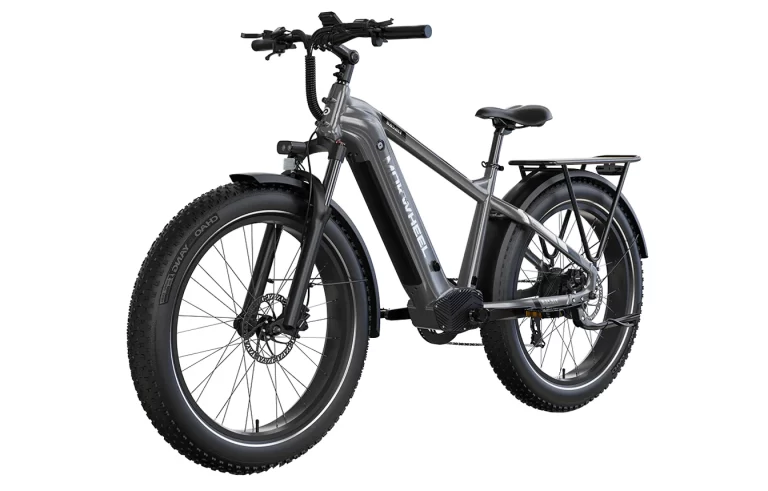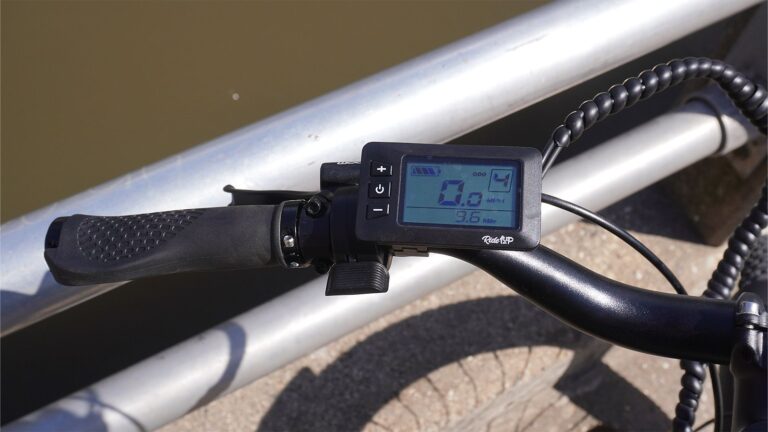How Far Can You Really Go on an E-Bike? (Maximizing Range Tips Included!)
Electric bikes (e-bikes) have revolutionized commuting and recreation. They offer a powerful assist that makes pedaling a breeze, conquering hills with ease and opening up new possibilities for exploration. However, for many potential e-bike riders, a shadow of doubt lingers – “range anxiety.” The fear of running out of battery power and getting stranded mid-ride can be a significant deterrent.
This post is here to conquer that fear! We’ll delve into the factors that influence e-bike range, empowering you to make informed decisions and maximize the distance you can travel on a single charge. From understanding battery capacity to mastering efficient riding techniques, we’ll equip you with the knowledge to confidently explore on your e-bike. So, ditch the range anxiety and get ready to experience the full potential of electric biking!
Key Takeaways
1. Demystifying E-Bike Range:
Several factors influence e-bike range, and it’s not a one-size-fits-all answer. Battery capacity (measured in Watt-hours, Wh), motor power, rider weight, terrain, riding style, and even weather conditions all play a role. A larger battery with a higher Wh rating generally translates to a longer range. More powerful motors can propel you further, but also consume battery power faster. Heavier riders and hillier terrain demand more energy from the motor, reducing range. Aggressive riding with frequent use of the highest assist level and throttle will drain the battery quicker compared to a more relaxed pace with efficient pedaling. Even wind resistance and cold temperatures can slightly impact range.
2. Range Calculators: A Starting Point, Not a Finish Line
Many e-bike manufacturers and online resources offer e-bike range calculators. These tools can be helpful for getting a general idea of potential range based on various factors you input. However, it’s important to remember that these are estimates. Real-world factors like wind, frequent stops and starts, and variations in terrain can significantly impact the actual range you achieve.
3. Maximize Your Range: Ride Smart, Plan Ahead, Maintain Well
The good news is that you have significant control over maximizing your e-bike’s range! Here are some key strategies:
- Riding Techniques: Utilize pedal assist efficiently, minimize reliance on the throttle, and maintain proper tire pressure for optimal efficiency. Shift gears effectively, especially on hills, to reduce strain on the motor.
- Pre-Ride Planning: Plan your route to minimize hills and headwinds whenever possible. A flat and sheltered route allows your e-bike to operate at its most efficient, maximizing your range. Pack light and avoid carrying unnecessary weight.
- Regular Maintenance: A well-maintained e-bike with a healthy battery performs better and delivers optimal range. Follow the manufacturer’s recommendations for charging, storage, and overall care of your e-bike.
4. High Range and Fast Charging: Power at a Premium
For riders seeking to push the boundaries of exploration and minimize downtime, e-bikes with high-range batteries and fast-charging capabilities are a game-changer. These e-bikes typically boast larger batteries with higher Wh ratings and utilize powerful chargers that significantly reduce charging time compared to standard options. However, this added power and convenience often come at a higher price point.
5. Budget-Friendly Options: Balancing Affordability and Range
While high-range e-bikes offer undeniable advantages, there are budget-friendly options available that can provide decent range for casual rides or commutes. These e-bikes might have smaller batteries and prioritize efficiency over top speed or power. The key here is to strike a balance between affordability and features that meet your needs. Don’t sacrifice quality for an extremely low price, as this could lead to performance or durability issues down the road.
6. Cargo Considerations: When Your E-Bike Needs to Haul More
If you plan on using your e-bike for grocery shopping or carrying other gear, consider e-bikes specifically designed for cargo capacity. These e-bikes often feature sturdy frames to handle the extra weight, built-in racks or pannier compatibility for secure cargo transportation, and sometimes even longtail or cargo bike designs that prioritize hauling capabilities.
7. E-Bikes vs. Gas-Powered Options for City Commutes:
For city commutes, e-bikes offer a compelling alternative to gas-powered vehicles. They can comfortably handle typical commute distances with proper planning, and readily available charging stations in many cities further alleviate range anxiety. With lower running costs, no emissions, and a convenient riding experience, e-bikes are a perfect choice for navigating the urban jungle.
Uderstanding E-Bike Range: Demystifying the Numbers
Ever wondered how far you can truly travel on a single charge with your e-bike? Unlike a gas tank with a clear fill-up point, e-bike range can feel a bit more mysterious. Here’s the key to unlocking the secrets: Watt-hours (Wh).
Watts and Hours: The Power Duo:
Imagine your e-bike battery as a reservoir of energy. Wh is a unit that tells you the total amount of energy stored, just like gallons tell you the volume of liquid in a tank. It’s calculated by multiplying the battery’s voltage (V) by its capacity in Amp-hours (Ah). For example, a 36V battery with a 10Ah capacity would have a total of 36V x 10Ah = 360Wh of energy.
“Average Range” – A Starting Point:
E-bike manufacturers often advertise an “average range” for their models. This number is typically based on controlled test conditions, like riding on flat terrain with a specific rider weight and moderate pedal assist. While it offers a general idea, it’s important to remember that real-world factors can significantly impact your actual range.
The Reality Check: Real-World Factors Take the Wheel
The advertised “average range” is just the beginning of the story. Here’s how real-world factors can influence your actual e-bike range:
- Terrain: Hills, as mentioned earlier, demand more power from the motor, draining the battery faster. Conversely, flat surfaces allow for efficient cruising, maximizing your range.
- Rider Weight: Remember, the heavier the load (rider and cargo), the harder the motor has to work, impacting range.
- Riding Style: High pedal assist levels, frequent throttle use (if applicable), and minimal pedaling effort all contribute to increased battery consumption. Conversely, using a lower assist level, strategic throttling, and putting in some pedal power can significantly extend your range.
- Weather: While not as significant as other factors, cold temperatures can slightly reduce battery performance.
E-Bike Range Calculators: A Helping Hand (with a Disclaimer)
Several online e-bike range calculators exist. These tools can be helpful for getting a rough estimate of your potential range based on various inputs like battery capacity, motor power, and rider weight. However, remember that these calculators rely on averages and may not account for all the real-world variables mentioned above.
The Takeaway:
Understanding Wh and the various factors affecting e-bike range empowers you to make informed decisions for your rides. Consider the “average range” as a starting point, but be prepared to adjust your expectations based on your specific riding style and environment.
RELATED CONTENT – On the Go Strategies for Charging an Electric Bike While Traveling
Factors Affecting E-Bike Range (for Beginners):
Understanding the factors that influence your e-bike’s range is key to conquering range anxiety. Let’s break down some of the key players:
1. Battery Capacity:
The heart of your e-bike’s range lies in its battery. Battery capacity is measured in Watt-hours (Wh), which tells you the total energy stored. Think of it like a fuel tank for your e-bike. The higher the Wh rating, the more “fuel” you have available, translating to a longer potential range.
Here’s the simple analogy: A larger gas tank in your car allows you to travel further before needing a refill. Similarly, a higher Wh battery on your e-bike lets you ride for a longer distance before needing to recharge.
2. Motor Power:
The motor on your e-bike acts like an engine, providing the electric assist that propels you forward. However, just like a car engine, the motor’s power (measured in watts) impacts efficiency and ultimately, range.
Here’s the logic: A more powerful motor (higher wattage) can propel you faster and tackle steeper hills with ease. But, this extra power comes at a cost – it consumes more battery power to deliver that extra oomph. For flat commutes, a less powerful motor might be sufficient, conserving battery life for longer rides.
3. Rider Weight:
Let’s face it, physics plays a role! The heavier the rider and any cargo, the more work the motor needs to do to maintain speed. This translates to increased battery drain. While lighter riders naturally enjoy a bit of a range advantage, don’t despair if you tip the scales a bit higher. We’ll explore some tips later in the post on maximizing your range even as a heavier rider.
4. Terrain:
The path you choose significantly impacts your e-bike’s range. Here’s how different terrains affect battery consumption:
- Hills: Conquering those inclines feels fantastic with an e-bike’s assist, but it also demands the most from your battery. The motor has to work harder to overcome gravity, draining battery life faster.
- Wind Resistance (Headwinds): Just like a cyclist battling a headwind, your e-bike faces the same challenge. Headwinds create drag, forcing the motor to work extra hard to maintain speed, and consequently, reducing your range.
- Flat Surfaces: Smooth, flat terrain is your e-bike’s happy place. With minimal resistance, the motor operates most efficiently, maximizing your range on these ideal conditions.
5. Riding Style:
The way you ride your e-bike plays a big role in how far you can go on a single charge. Here’s how your choices can impact range:
- Pedal Assist Level: Most e-bikes offer various levels of pedal assist. Higher assist levels provide more power but drain the battery faster. For longer rides, consider using a lower assist level and put in some extra pedal effort to conserve battery life.
- Throttle Use (if applicable): Some e-bikes have a throttle that allows you to control speed without pedaling. While convenient for short bursts, throttle use is generally less efficient than pedal assist, draining the battery quicker.
- Rider Effort: Don’t underestimate the power of your own legs! By putting in some effort and pedaling alongside the motor assist, you significantly reduce the load on the battery, extending your potential range.
6. Weather
Electric bike batteries do drain faster in cold weather. While not as significant a drain as other factors, colder temperatures can slightly reduce battery performance. Lithium-ion batteries, the workhorses of most e-bikes, have a lower capacity when cold. This doesn’t mean you have to ditch your winter rides, but be prepared for a bit shorter range on those chilly days.
RELATED CONTENT – Ultimate Guide to Electric Bike Commuting
RELATED CONTENT – Can You Ride an Electric Bike in the Rain?
E-Bike vs. Gas Bike Range for City Riding: Rethinking the Commute
For many city dwellers, the daily commute can be a time-consuming and sometimes frustrating experience. Traffic jams, limited parking options, and rising gas prices can make you yearn for a more efficient and cost-effective way to navigate the urban jungle. This is where e-bikes enter the scene, offering a compelling alternative to gas-powered scooters and motorcycles.
Range Rundown:
Let’s compare the typical range of these two options for city riding:
- E-bikes: The average range of e-bikes on a single charge can vary depending on battery capacity and factors discussed earlier. However, for typical city commutes (think 5-15 miles), most e-bikes can comfortably handle the distance with power to spare. Additionally, with readily available charging stations popping up in many cities, topping up your battery during the day can further extend your range anxiety-free exploration.
- Gas-powered Scooters/Motorcycles: While gas-powered options might boast a seemingly longer range on a single tank, factors like stop-and-go city traffic can significantly reduce their fuel efficiency. Additionally, finding parking for a larger vehicle in a crowded city center can be a daily struggle.
Beyond Range: The E-Bike Advantage
When it comes to city commuting, e-bikes offer several advantages beyond just comparable range:
- Lower Running Costs: Ditch the gas pump! E-bikes require electricity to recharge, which translates to significantly lower running costs compared to gas-powered vehicles.
- Convenience: E-bikes are often lighter and easier to maneuver than gas-powered options, making them ideal for navigating through city streets and battling traffic. Finding parking becomes a breeze with compact e-bikes that can easily fit on bike racks or even tucked away in an office corner.
- Eco-Friendly: Let’s face it, gas emissions are a major concern in crowded cities. E-bikes offer a clean and environmentally friendly way to navigate the urban landscape, reducing your carbon footprint and contributing to cleaner air.
The Choice is Clear:
For city commuters, e-bikes offer a compelling combination of range, convenience, lower running costs, and environmental friendliness. With their ability to handle typical commute distances and readily available charging options, e-bikes empower you to ditch the gas station, embrace a more relaxed commute, and contribute to a cleaner city environment.
Maximizing Your E-Bike Range: Ride Further, Worry Less
Conquered by range anxiety no more! Now that you understand the factors influencing e-bike range, let’s explore some practical tips to maximize your distance on a single charge and turn those worries into watts of confidence:
Mastering the Art of Efficiency:
Your riding technique plays a significant role in extending your e-bike’s range. Here are some key strategies to embrace:
- Tire Pressure Tune-Up: Just like a car with flat tires, an e-bike with underinflated tires creates rolling resistance, forcing the motor to work harder and drain the battery faster. Maintaining proper tire pressure (as recommended by your e-bike’s manual) ensures smooth rolling and optimal efficiency.
- Shifting Smarts (Especially on Hills): Utilize your e-bike’s gears effectively, especially when tackling those climbs. Shifting to a lower gear on hills allows you to maintain a steady cadence (pedaling rate) with less strain on the motor, preserving precious battery life.
- Pedal Assist Prowess: Most e-bikes offer various levels of pedal assist. For longer rides, consider using a lower assist level. While it might require a bit more effort on your part, it significantly reduces battery consumption compared to constantly relying on the highest assist setting.
- Throttle Control (if applicable): For e-bikes with throttles, avoid overuse. While convenient for short bursts, throttle use is generally less efficient than pedal assist, draining the battery quicker. Use the throttle strategically and rely on pedal power for optimal range.
Pre-Ride Planning: A Strategic Advantage
Just like a well-planned road trip, a little pre-ride planning for your e-bike adventure can significantly extend your range and combat range anxiety. Here’s how:
- Route Reconnaissance: Charting a Course for Efficiency
Think of your e-bike’s battery as a precious resource. Planning your route with efficiency in mind allows you to get the most out of it. Here’s what to consider:
- Terrain: If possible, prioritize flat or gently rolling terrain. While conquering hills with your e-bike’s assist is exhilarating, remember they are battery drainers. Use online mapping tools to identify routes with minimal elevation changes.
- Wind Warriors: Check the weather forecast for wind direction and speed. Strong headwinds (winds blowing directly against you create significant drag, forcing the motor to work harder and reducing your range. If possible, plan your route to avoid strong headwinds, or choose a route that offers some wind protection from buildings or natural features like trees.
- Pack Light: Travel Like a Pro: The weight you carry on your e-bike, including your own body weight and any cargo, directly impacts your range. The heavier the load, the more energy the motor needs to expend to maintain speed. Here are some ways to pack light:
- Essentials Only: For longer rides, pack only the essentials you’ll absolutely need – water bottle, snacks, basic repair kit, and maybe a change of clothes depending on the weather. Leave non-essentials behind.
- Layering Up: Dress in layers for changing weather conditions instead of packing bulky clothing options.
- Cargo Considerations: If carrying groceries or other essentials is a must, explore e-bikes specifically designed for cargo capacity These e-bikes often have sturdier frames and motors built to handle the extra weight more efficiently.
By incorporating these pre-ride planning strategies, you can significantly reduce the strain on your e-bike’s battery and extend your range, allowing you to explore further and conquer range anxiety with confidence.
Tips for Extending E-Bike Range as a Heavier Rider
Being a heavier rider shouldn’t limit your electric bike adventures. Here are some strategies to maximize your e-bike’s range:
Optimizing Your Ride:
- Master the Gears: Utilize your e-bike’s gears effectively, especially on hills. Shifting to a lower gear on inclines lets you maintain a steady pedaling rate with less strain on the motor, preserving battery life.
- Embrace Eco-Mode: While it might feel slower, using lower assist levels extends your range significantly. You’ll get more exercise and contribute to battery efficiency.
- Plan Your Route: Choose routes with less resistance, like flat terrain and smooth surfaces. Avoid strong headwinds and excessive stopping and starting.
- Maintain Momentum: Keep a steady pace and avoid unnecessary braking. Coasting whenever possible helps conserve battery power.
- Pack Light: Only carry essential items. The extra weight puts more strain on the motor and drains the battery faster.
Upgrading Your E-Bike (For Experienced Riders):
- Battery Capacity: Consider a larger, higher amp-hour (Ah) battery for a significant range boost. Talk to a qualified e-bike mechanic to ensure compatibility.
- Motor Choice: Mid-drive motors are generally more efficient for heavier riders. They distribute power through the drivetrain, reducing strain on the motor itself.
General Maintenance:
- Proper Tire Pressure: Maintain optimal tire pressure as recommended by your e-bike’s manual. Underinflated tires create rolling resistance, reducing range.
- Regular Servicing: Schedule regular maintenance to keep your e-bike in top condition. A well-maintained drivetrain minimizes friction and maximizes efficiency.
Remember:
- Colder temperatures can slightly reduce battery performance. Keep this in mind for winter riding.
- E-bikes are still bicycles! Pedal assistance is there to supplement your effort, so don’t be afraid to put in some work!
Maintenance Matters: Keeping Your E-Bike in Top Shape
Just like any other machine, your e-bike performs best when properly maintained. Here’s how regular maintenance can contribute to maximizing your range:
- Battery TLC: The battery is the heart of your e-bike’s range. Treat it with care by following the manufacturer’s recommendations for charging, storage, and overall care. This might include avoiding extreme temperatures during charging or storage, and following specific charging protocols. A healthy battery delivers optimal performance and helps you achieve maximum range.
Beyond the Basics:
While the manufacturer’s recommendations are key, here are some additional tips to consider:
- Cleanliness is Key: Regularly clean your e-bike, paying attention to the drivetrain (chain, cassette, derailleurs). A clean drivetrain reduces friction and allows the motor to operate more efficiently.
- Proper Tire Inflation: As mentioned earlier, maintaining proper tire pressure as recommended in your e-bike’s manual is crucial for optimal efficiency and range.
- Beware of Aftermarket Parts: While the internet might be filled with suggestions for aftermarket parts promising to boost battery life, proceed with caution. Stick to manufacturer-approved components and avoid modifications that could compromise the safety or performance of your e-bike.
By following these maintenance tips, you ensure your e-bike operates at peak efficiency, maximizing your range and allowing you to enjoy worry-free rides. Remember, a well-maintained e-bike is a happy e-bike, and a happy e-bike takes you further!
RELATED CONTENT – Complete Guide to Electric Bike Charging: Tips, Tricks & Best Practices
E-Bikes with High Range and Fast Charging: Conquering Distance and Time
For riders seeking to push the boundaries of exploration and minimize charging downtime, e-bikes with high range and fast charging capabilities are a game-changer. Let’s delve into these features:
- Built for Distance: E-Bikes with Bigger Batteries
Range anxiety? Not so much! E-bikes boasting larger battery capacities, often measured in Watt-hours (Wh), can significantly extend your rides. Imagine a battery with a capacity of 750Wh compared to a 400Wh battery. The 750Wh battery offers nearly double the potential range, allowing you to venture further on a single charge. These e-bikes might be slightly heavier due to the larger battery, but the trade-off for extended range can be very appealing for long-distance riders.
- Faster Charging: Get Back on the Road Sooner
Even with a high-range battery, there will eventually be a need to recharge. This is where e-bikes with fast-charging capabilities come in. These e-bikes utilize powerful chargers and compatible batteries that can significantly reduce charging time compared to standard options. Imagine cutting your charging time in half – instead of waiting for several hours, a fast-charging e-bike might be ready to roll in under two hours (depending on battery capacity and charger specifications).
Important Considerations:
While e-bikes with high range and fast charging offer undeniable advantages, here are some things to keep in mind:
- Higher Costs: Generally, e-bikes with larger batteries and fast-charging capabilities tend to come at a higher price point compared to their standard counterparts.
- Weight Considerations: As mentioned earlier, larger batteries add weight to the e-bike. While the range benefit is undeniable, some riders might prioritize a lighter e-bike for easier handling.
- Fast Charging Limitations: Fast charging technology is still evolving, and charging times can vary depending on the specific e-bike model, battery capacity, and charger used. It’s important to consult the manufacturer’s specifications for accurate charging times. Additionally, fast charging might require a specific charger, so ensure compatibility before relying solely on this feature.
The Takeaway:
E-bikes with high range and fast charging offer a compelling option for riders seeking to conquer long distances and minimize downtime. By understanding the trade-offs and considering your riding needs, you can determine if these features are a priority for your e-bike adventures.
Long-Range E-Bikes Under $1000: Striking a Balance
While long-range e-bikes often come with a hefty price tag, there are some budget-friendly options available that can offer decent range for casual rides. However, it’s important to remember that achieving extreme range under $1000 often requires some compromise. Here’s what to consider:
- Lower Battery Capacity: E-bikes in this price range typically have smaller battery capacities compared to their high-range counterparts. This translates to a shorter maximum range, but for commutes or leisure rides within a 15-20 mile radius, they can still be a practical option.
- Focus on Efficiency: Manufacturers might prioritize features that enhance efficiency, such as lightweight frames and fewer gears, to maximize the range of a smaller battery.
Finding the Right Balance: 3 Long-Range E-Bikes Under $1000
Here are three e-bikes under $1000 that offer a balance between affordability and decent range:
1. Lectric XP Lite
- Overview: A popular choice for budget-conscious riders, the Lectric XP Lite offers a good balance of affordability, range, and features.
- Features: 350w hub motor, 48v battery (capacity not publicly available but users report a 20-25 mile range on a single charge), 7-speed drivetrain, lightweight aluminum frame.
- Pros: Affordable price, comfortable ride, good customer service.
- Cons: Limited range compared to higher-priced options, mechanical disc brakes might lack stopping power for heavier riders on steep hills.
- Price Range: $799 (https://lectricebikes.com/collections/ebikes)
- Star Rating Reviews: 4.8 out of 5 stars based on over 1800 reviews on the Lectric Bikes website.
2. Nakto Camel Step-Thru
- Overview: This step-thru design offers easy mounting and dismounting, making it suitable for riders of all abilities.
- Features: 250w hub motor, 36v battery (20 mile max range), 6-speed drivetrain, comfortable cruiser style riding position.
- Pros: Easy to use, comfortable for cruising, affordable price.
- Cons: Limited power and range compared to some options, might not be ideal for tackling hills.
- Price Range: $499 (discounted price, typically around $899) (https://nakto.com/)
- Star Rating Reviews: 4.8 out of 5 stars based on 52 user ratings on the Nakto Official Store website. It’s important to note that the number of reviews is significantly lower than the Lectric XP Lite.
3. Hiboy S2 Pro
- Overview: This foldable e-bike prioritizes portability with a lightweight frame and folding design.
- Features: 350w brushless motor, 48v battery (30-40 mile range depending on use), 7-speed drivetrain, fully foldable frame.
- Pros: Folds for easy storage and transport, decent range for the price, lightweight and easy to maneuver.
- Cons: Smaller wheels might not be ideal for rough terrain, some users report concerns about long-term build quality.
- Price Range: $699 (https://www.hiboy.com/)
- Star Rating Reviews: 4.5 out of 5 stars based on over 400 user ratings on the Hiboy website. It’s important to note that the number of reviews is significantly lower than the Lectric XP Lite.
Remember: These are just a few examples, and it’s always wise to conduct your own research to find the e-bike that best suits your needs and budget. Be sure to consider factors like desired range, terrain you’ll be riding on, and weight capacity before making a final decision.
Additional Considerations: Finding the Perfect E-Bike for You
While maximizing range is an important factor for many e-bike riders, there are other considerations to keep in mind depending on your needs. Here’s one additional aspect to explore:
- Cargo Capacity: Hauling Your Essentials (and More!)
For riders who need to carry groceries, sporting equipment, or other cargo, choosing an e-bike with good cargo capacity becomes crucial. These e-bikes often feature:
- Sturdy Frames: Designed to handle the extra weight of cargo without compromising performance.
- Rear Racks and Pannier Systems: Built-in racks or compatibility with pannier bags allow for secure and convenient cargo transportation.
- Longtail or Cargo Bike Designs: These e-bikes feature extended tail sections or front cargo areas specifically designed to maximize hauling capabilities
By considering your cargo needs, you can ensure your e-bike is not only efficient but also functional for your lifestyle. Remember, the perfect e-bike is the one that meets all your transportation requirements!
FAQs
There’s no one-size-fits-all answer, as e-bike range depends on several factors like battery capacity, rider weight, terrain, riding style, and weather. However, most e-bikes can comfortably handle commutes or leisure rides within a 15-20 mile radius on a single charge. High-range e-bikes with larger batteries can reach distances upwards of 50 miles.
Here are some key strategies:
Utilize pedal assist efficiently: Lower assist levels require less battery power compared to the highest setting.
Minimize throttle use (if applicable): Rely on pedaling for most of your ride and use the throttle sparingly for bursts of speed.
Maintain proper tire pressure: Underinflated tires create drag, forcing the motor to work harder and drain the battery faster.
Shift gears effectively (especially on hills): Using lower gears on hills reduces strain on the motor and conserves battery life.
Plan your route to minimize hills and headwinds: Flatter terrain and routes with minimal headwinds allow your e-bike to operate at optimal efficiency.
Pack light: The lighter the load (rider and cargo), the less energy the motor needs to expend.
Yes! E-bikes with fast-charging capabilities are becoming increasingly popular. These models utilize powerful chargers and compatible batteries that can significantly reduce charging time compared to standard options. However, fast charging typically comes at a higher price point and might require a specific charger.
While achieving extreme range under $1000 is challenging, there are some budget-friendly options with decent range suitable for casual rides or commutes within a 15-20 mile radius. Remember, these e-bikes might have smaller batteries and prioritize efficiency over top speed or power.
Consider e-bikes specifically designed for cargo capacity. These models often feature sturdy frames, rear racks or pannier compatibility, and sometimes even longtail or cargo bike designs to maximize hauling capabilities.
Conclusion
Understanding e-bike range and implementing the tips discussed in this post empower you to conquer range anxiety and unlock the full potential of your electric adventures. Remember, e-bikes offer a fun, eco-friendly, and efficient way to navigate your world. Whether you’re seeking extended commutes, leisurely cruises, or exercise with a boost, there’s an e-bike perfectly suited for your needs.
Ready to ditch the gas pump, embrace the open road, and experience the joy of e-bike riding? Explore the diverse range of e-bikes available, consider the factors that influence range, and put these maximizing tips into practice. We’d love to hear about your e-bike experiences! Share your comments and questions below – what are your biggest range concerns? How do you maximize your e-bike rides? Let’s keep the conversation rolling and empower a new generation of e-bike enthusiasts together!
External Sources
- EbikeSchool.com – What Is Range Anxiety? (https://www.ebikeschool.com/range-anxiety/) explores the concept of range anxiety and offers additional tips to increase your e-bike’s range.
- CYCROWN – All Terrains Premium Performance Electric Bike (https://www.cycrown.com/) This product page highlights an e-bike with a focus on efficiency, indirectly promoting strategies to maximize range through bike selection.
Pre-Ride Planning: Efficiency is Key
Strategic route planning can significantly extend your e-bike’s range. Here are some resources to help you plan efficient rides:
- MapQuest: https://www.mapquest.com/ or Google Maps: https://www.google.com/maps : Utilize online mapping tools to identify routes with minimal elevation changes and explore wind patterns (use the forecast feature) to avoid strong headwinds.
E-Bikes with High Range and Fast Charging
For riders seeking to push the boundaries of exploration, e-bikes with high-range batteries and fast-charging capabilities are a game-changer. Here are some resources to explore these features in more detail:
- **Specialized Turbo Como SL Expert: [invalid URL removed] (Note: While this specific e-bike is not under $1000, it is a good example of a high-range e-bike with a fast-charging battery) This product page showcases an e-bike with a long-range battery and fast-charging capabilities.
Long-Range E-Bikes Under $1000
Finding an affordable e-bike with decent range is possible. Here are some resources to get you started on your research:
- Lectric XP Lite ([https://lectricebikes.com/collections/ebikes]) This e-bike is a popular choice for budget-conscious riders and offers a good balance of affordability, range, and features. Be sure to visit the manufacturer’s website for detailed specifications.
Additional Considerations: Finding the Perfect E-Bike for You
E-bike needs and preferences vary. Here’s a resource to explore e-bikes designed for specific purposes:
- **Yutrax X Fat Tire Electric Bike: [Yutrax X Fat Tire Cargo Ebikes] (Note: While this specific e-bike is not under $1000, it is a good example of an e-bike designed for cargo capacity) This product page showcases an e-bike designed for cargo hauling, highlighting features to consider if you plan on carrying groceries or other gear.
Kristina Grant is not just an enthusiast but a true authority on electric bikes. Nestled in the coastal beauty of Virginia, Kristina has found the perfect backdrop for her passion for electric biking. As a dedicated wife and homeschooling mom, her life revolves around family, faith, and the thrill of adventure.
Originally hailing from Ohio, Kristina's journey with electric bikes began as a curiosity and quickly evolved into a deep expertise. Her blog is a testament to her love for electric biking, combining her fascination for eco-friendly transportation with her coastal lifestyle.
When she's not cruising the beach on her electric bike, you'll find Kristina indulging in her other loves: long walks along the shore, getting lost in a good book, and cherishing moments with her loved ones. With a heart as big as her love for animals, especially cats, Kristina brings a unique perspective to the electric bike world, grounded in her strong faith in God and her dedication to a sustainable lifestyle.
Through her blog, Kristina shares her extensive knowledge of electric bikes, offering valuable insights, tips, and recommendations to fellow enthusiasts. Whether you're a seasoned rider or a newcomer to the electric bike scene, Kristina's blog is your go-to source for all things electric biking, fueled by her passion, expertise, and the scenic beauty of coastal Virginia.


